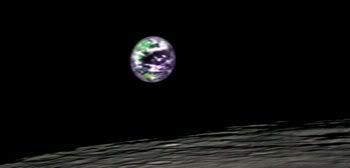Science bits

Apparently, we really do walk around in circles when we're lost:
Scientists in the Multisensory Perception and Action Group at the Max Planck Institute for Biological Cybernetics in Tübingen, Germany, led by Jan Souman and Marc Ernst, have now presented the first empirical evidence that people really walk in circles when they do not have reliable cues to their walking direction....
The scientists used the global positioning system (GPS) to record these trajectories. The results showed that participants were only able to keep a straight path when the sun or moon was visible. However, as soon as the sun disappeared behind some clouds, people started to walk in circles without even noticing it.
And they include a video:
They hypothesized that some people in the experiment may be circling because of different leg lengths of the subjects (a common trait, though rarely noticeable) or that one leg is stronger. So they blindfolded their subjects and told them to stagger around to rule out the effect. They found that the same people waffle back and worth, either moving to the right or moving to the left. This means leg length or strength isn't an issue, and when directional cues are removed, people wander all over the place.
Marc Ernst, Group Leader at the MPI for Biological Cybernetics, added: "The results from these experiments show that even though people may be convinced that they are walking in a straight line, their perception is not always reliable. Additional, more cognitive, strategies are necessary to really walk in a straight line. People need to use reliable cues for walking direction in their environment, for example a tower or mountain in the distance, or the position of the sun." In future research, Souman and Ernst will focus on how people use these and various other sources of information to guide their walking direction.
So the moral is never be lost without a map or your Garmin.
Last October, India launched their first lunar probe, Chandrayaan-1, a testament to the growing accessibility of space. It was awesome, completed excellent analyses like those of the Moon's mysterious darkened poles which may contain water ice, and returned some great photographs, including this wonderful shot of Earth sitting over the lunar horizon:

Sadly though, not even at the halfway point of its mission, Chandrayaan-1 stopped transmitting, and it's been announced by officials that it's over:
"Our efforts to establish contact have failed. The mission has been terminated," ISRO spokesperson S. Satish told Reuters. "There was no point continuing with the mission."
Emily Lakdawalla of The Planetary Society's blog quotes IBNLive in their interview with Satish, which provides a bit more info:
[S]cientists were unable to know what is happening to the spacecraft because of the snag. He said ISRO was not in communication with Chandrayaan 1 and was unable to determine what was happening to the spacecraft after the radio link was lost. 'We are not able to establish communication with the spacecraft--that is what we mean by loss of radio link. It is some sort of serious problem. We are not able to establish communication with the spacecraft, so we are not able to know what is happening to the spacecraft. This anomaly is being analysed from the data received last.'
She then asks the obvious:
An obvious question seems to be: why did ISRO give up so quickly? It's been less than two days since the loss of contact. I don't have an answer for that.
Perhaps it may lie with the spacecraft's design. If they received the right error message, then after a few tries of trying to reestablish the link, they would know that further attempts would be hopeless. Anyway, it's a sad day for lunar exploration, but I hope it doesn't discourage India from further space exploration.
Well, it's not exactly as Crichton envisioned it, but we all know his was blinkered:
After years spent hunting for the buried remains of prehistoric animals, a Canadian paleontologist now plans to manipulate chicken embryos to show he can create a dinosaur.
Hans Larsson, the Canada Research Chair in Macro Evolution at Montreal's McGill University, said he aims to develop dinosaur traits that disappeared millions of years ago in birds.
Larsson believes by flipping certain genetic levers during a chicken embryo's development, he can reproduce the dinosaur anatomy, he told AFP in an interview.
It all has to do with development of the embryo while inside the mother. As embryos develop, certain chemicals are released in certain orders that allow genes or sets of genes to flip on and off. By studying what chemicals control which genes, you can manipulate them to your likening. If, for example, you want to produce a fruit fly with eyes on its knees, all you need to do is overexpress the genes that control eye development and direct that info to where the knee is forming. Viola! Eyes on the knees.
Same thing with a chicken. Geneticists have already expressed the genes with chemicals that control teeth development and made chickens with teeth in their beaks. All you need to do then is express those genes that can produce scales, tails, and other dinosaur-like features and... Viola! A dinochicken.
The wonderful part about this is that the chicken already has the genes and sets of genes needed to create these features. There's no Jurassic Park-style genetic engineering going on here, no tacking on bits from whatever genome extracted from fossilized amber needed to produce dinosaurs. Larsson is simply talking about manipulating what's already present.
Of course, the automatic question is why chickens would have genes that can create teeth, scales, and dino tails when they don't develop them, and the answer only makes sense if evolution is a reality. Chickens are descended from dinosaurs, and those old genetic switches that once coded for scales and teeth were coopted and/or supressed during evolution and now produce feathers and beaks or are shut down altogether. Larsson is beautifully correct when he says this would be a "demonstration of evolution." A powerful and elegant demonstration.
Unfortunately the process is still in its infancy, so no dinochickens will be grazing pastures any time soon. Still, the science is all right there, and the applications are numerous. After all, who doesn't want to have Kentucky-fried dinosaur?
Want to know what'll happen in the impending zombie apocalypse? Well so did students and a professor at the Department of Mathematics and Faculty of Medicine at the University of Ottawa, basing they study on already-existing models on the spread of infections so we can prepare for doomsday.
They assume zombies are forming because of a virus spreading through the population and then postulate several scenarios: a zombie outbreak, a zombie outbreak with a latent infection, a zombie outbreak with quarantine procedures, a zombie outbreaks when treatment is discovered, abd a zombie outbreak when zombies are killed immediately and en masse. Really though these match real-world scenarios of any kind of infection of any disease, or even the spread of ideas and worldviews like allegiances to political parties. The model works equally well of all of these -- even zombie outbreaks.
Three categories are assigned to the population. There's the susceptibles, S, that are uninfected humans; the removed, R, which are dead people (which can become zombies later) and destroyed zombies; and the infected, I, or the zombies still jerking around. (In this case they call the infected simply "zombies", or Z.) Other values come later, like Q for quarantined individuals or I for those infected but haven't turned yet.
So what happens when the undead rise and what should we do? Well to get some numbers to put things in perspective, they say that the zombies can overtake a city of 500,000 people in 3 days. Quarantine only delays the inevitable, and a cure for the zombie virus can lead to zombies and humans living together, but are still a lasting threat. The only way to deal with an outbreak, the study says, is complete eradication:
[T]he most effective way to contain the rise of the undead is to hit hard and hit often. As seen in the movies, it is imperative that zombies are dealt with quickly, or else we are all in a great deal of trouble.
So, unless the military is out there dropping nuclear bombs on cities, raid your local Wal-Mart of axes and sledgehammers and bone up on your survival skills. Because the zombies are here to stay.